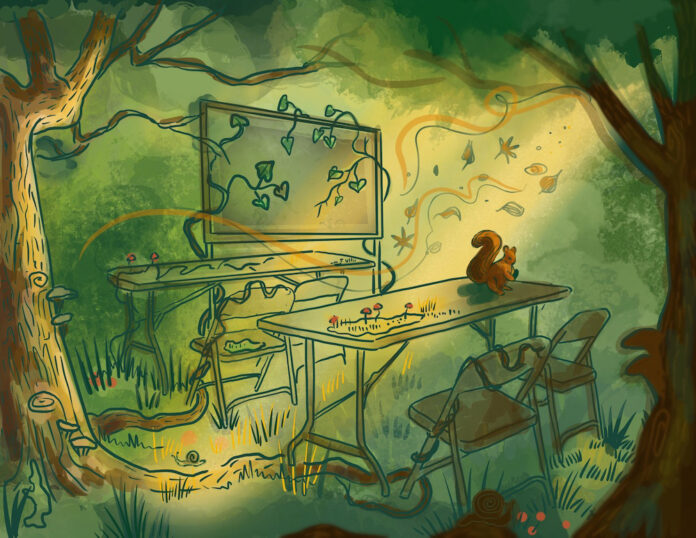On move-in day while driving up to my dorm, I noticed tents set up around campus and thought they were part of the many functions, like Orientation, being held before classes started. I soon realized they weren’t temporary constructions — they were classrooms. Before I express my distaste for outdoor classrooms, I must first give them the credit they deserve. Having classrooms outside gives students who feel comfortable the option of not wearing a mask. In indoor settings we are required to wear masks, and with college classes that can be upwards of two hours, wearing a mask can become uncomfortable.
In addition, with or without mask wearing, outdoor classrooms decrease the viral transmission rate for COVID-19. Since these classrooms are one way for us to continue learning in person, we need to refine our approach for making them effective spaces.
In outdoor classrooms, there are no walls to create a buffer between the classroom and the outside world. The absence of this buffer creates one major problem — distractions. When it is windy, I can hear leaves rustling and see trees dancing. Suddenly I am focused on the squirrels climbing up the trees or handouts flying away, instead of my class. You feel every bit of heat when it is 90 degrees outside and every goosebump when it’s breezy. The weather, the trees, the animals and the insects are now part of the learning environment.
Aside from the distractions brought on by the environment, there are also interruptions created by humans. Imagine you are sitting in one of the outdoor classrooms. People are having a conversation and now all you can focus on is their voices. You hear every footstep and every laugh. Suddenly there’s a runner, now a skater, and instead of being present in class you find yourself paying more attention to what is happening around you.
Fortunately for me, I have my outdoor class in a secluded area. Therefore, loud conversations or other forms of human disruptions are rare. However, there are outdoor classes on campus near more populated areas like the Marketplace or Weingart. I can’t even imagine how hard it is to focus in one of these busier spaces, especially during the huge lunch rush.
How can we change our approach? How can the Occidental community prioritize minimizing distractions?
Jeane McCarthy, CEO of Out Teach, provides a step-by-step guide to building an outdoor classroom. In her writing, she talks about the importance of a classroom’s location. She focused more on K-12 schools explaining that classrooms should not be located near areas like athletic fields or playgrounds because other children are frequently in those areas. She goes on to say that these locations should have shade and be equipped with whiteboards, which Occidental already accommodates.
Oxy has also provided tents to keep us from melting in the sun like popsicles in the hot LA weather. However, shade can only do so much. It would be helpful if the tents had fans available too. To deal with the wind outside it might help if professors made their classes more paperless — I personally want to spend less class time fighting the wind to keep my papers.
As students, we should also come to class prepared. Knowing that class will be outside, we can dress according to the weather report to avoid feeling uncomfortable. This is the time to bring out those hand-held fans with water sprayers that we only ever use for theme parks. Unlike the weather, human distraction is an external stimulus that we can control. In a recent campus-wide email, Wendy Sternberg, vice president of Academic Affairs and dean of the college, emphasized the importance of minimizing noise levels while passing outdoor classrooms. To help with this problem Sternberg announced that the college will post signs around outdoor classrooms reminding passersby to be quiet. I think this is a great way to remind people to respect the outdoor classroom environment. The school should also consider moving outdoor classrooms to areas that are not as busy to minimize human distraction. At the end of the day, making these new learning environments successful will be a group effort.
![]()



































